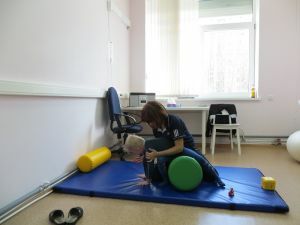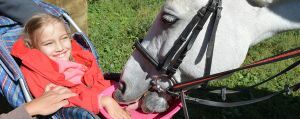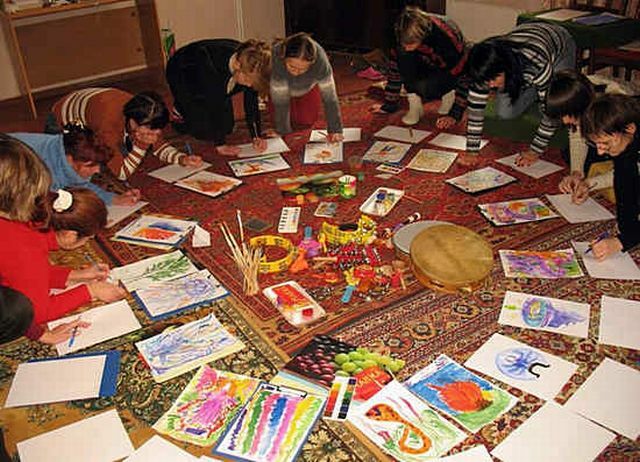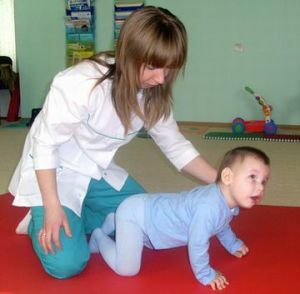 Bobat-therapy( neurodynamic rehabilitation) - is a neuro-developing practice, the purpose of which is to correct motor stereotypes, insufficient movements. The main area of application is the restoration of proper movements in the disease of cerebral palsy.
Bobat-therapy( neurodynamic rehabilitation) - is a neuro-developing practice, the purpose of which is to correct motor stereotypes, insufficient movements. The main area of application is the restoration of proper movements in the disease of cerebral palsy.
The name of the technique was the surname of its developers - Bertha and Karl Bobatov - doctors from London. Bertha worked as a physiotherapist, and her husband was a neurophysiologist, a professor of neurology and psychiatry.
In the 40's of the XX century.they proposed a cardinally new, as at that time, approach to the treatment of diseases associated with spastic musculature. In the 50's the therapy became quite popular throughout Europe.
The principles and mechanisms of the method were based on observations of patients who suffered strokes or trauma to the nervous system that Burt held. Karl did the theoretical justification.
The main idea of the method - the psyche and the body should interact, as a consequence - not a separate part of the body should be treated, but the whole organism as a whole. The goal of the technique is to develop manageable, rational and conscious movements, and at the same time to reduce muscle spasms and tension.
To date, centers working on the methodology of the Bobat couple, are found all over the world. This method of treatment for many years of practice has proved to be the most effective in restoring children with cerebral palsy and the consequences of many diseases, therefore official medicine recognizes it.
Contents of
- In which areas does Bobat therapy apply?
- Concept and principles of
- To whom is the method contraindicated?
- At what age can
- be treated? How are Bobat sessions conducted?
- One of the sets of exercises
- Parental opinion
In what areas does Bobat therapy apply?
This technique is used to treat such diseases:
- cerebral palsy of any severity;

- various defects associated with the development of the spinal canal;
- scoliosis( severity any);
- disorders in motor development;
- congenital or acquired in childhood hip dislocations;
- the consequences of various injuries( including postpartum), because of which the child lost control of the body;
- strokes;
- is an adverse manifestation of brain inflammation.
Concept and principles of
The concept of this technique is based on the idea of a genetic plan for the development of the central nervous system( CNS).This plan is nothing more than a healthy child development program.
In the infant from birth, basic reflexes are laid, due to which he communicates and contacts with the surrounding and habitat.
This method of communication is effective during the first 2-3 months of the child's life. After that, he begins to develop another kind of behavior, regulated and stimulated at the touch level from the outside.
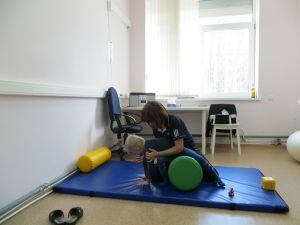 When a large number of different kinds of signals arrive for these or other analyzers, their processing takes place and, as a result, the child learns to develop appropriate motor reactions.
When a large number of different kinds of signals arrive for these or other analyzers, their processing takes place and, as a result, the child learns to develop appropriate motor reactions.
Because of the disease, the brain can receive distorted signals and, accordingly, will process them incorrectly. This leads to the development of pathologies in motor reactions, as well as to various complications( atrophy, contracture, spasticity, etc.).
The method of Bobat therapy involves the use of special signals( visual, auditory, body positions), the purpose of which is to make the CNS structures work and correct their work with the subsequent suppression of pathological motor reflexes.
Principles of Bobat therapy:
- treatment should be painless;
- child can not be adjusted, it needs some time to adapt;
- it is important to follow the sequence of stages of normal motor development of the patient;
- process of rehabilitation should be diverse and complex;
- movement must be carried out qualitatively and correctly;
- apply special postures that inhibit the development of pathological reflexes;
- the patient should trust you so much so that during exercises he completely relaxes his muscles;
- work collectively: the family, educators and various specialists( speech therapists, orthopedists, psychologists, teachers) should be engaged with the child in order to involve all directions of the CNS development;
- needs to really assess the child's capabilities and communicate them to their parents;
- regularly conduct repeated examinations of the patient to correct the treatment system;
- patient is important to adapt to life in society.
To whom is the method contraindicated?
There are several diseases in which the use of this technique is prohibited:
- Schizophrenia - the use of the method is strictly prohibited.
- Epilepsy - in this case you need to be very careful. Treatment is possible only with mild disease, with severe it is prohibited.
- Convulsive readiness in the expressed form - application of such treatment can aggravate the course of the disease.
- With , chronic diseases if they passed into the acute stage of .
At what age can the treatment begin?
The age of the child when working with the Bobat method does not matter: it can be like a baby, like a teenager. But, of course, the earlier 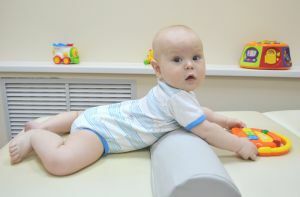 to begin - the more effective the treatment.
to begin - the more effective the treatment.
The best results are provided by the treatment process started, until the child has completed three months, when the sensory information just begins to accumulate.
Also, the process of treatment can begin as with minimal brain dysfunction, and in severe cases of organic pathologies.
How are Bobat classes taught?
Specialists deal with children in special game rooms. Classes are conducted in the form of games in order to establish greater contact with the patient.
Here, through the toys, the doctor sends the child's body certain signals, thanks to which the development potentials, which are laid down at the genetic level, are not revealed, which do not allow the formation of pathological functions.
Each action of this technique is aimed at the patient achieving one of the following goals:
- Inhibition of - to retain or inhibit involuntary movements of the patient's body.
- Facilitation - the use of directional movements. The specialist conducts stretching and relaxation exercises for the muscles of the body. Then he conducts exercises with those or other limbs of the patient with the purpose that the body will remember exactly how to move, at what rate, and used this action in the future.
- Stimulation of the patient to achieve the desired goal of .The occupation does not just include the child's favorite games, they specifically include different elements of the service, which the patient must master independently.
One of the exercise complexes
A set of exercises using Bobat therapy:
- We select the initial position .When working with the upper limbs, the patient can sit on a chair or lie on the couch. With
 other exercises, he must lie.
other exercises, he must lie. - Relax the brush .It is necessary to take the thumb of the spastic brush and smoothly move it to the outer part of the brush. Move with this should be the place where the finger passes into the wrist. Try not to hurt the child. Hold the finger in this position for up to 3 minutes to allow the muscles to relax. After relaxation of the spastic muscles, you need to take the tips of the remaining fingers and gently unbend, without touching the palm of your hand. Take care that the procedure does not cause the child pain. After the maximum extension of the fingers, the wrist is bent, unbent, retracted. The position of the thumb does not change.
- We bend the shoulder of .Hold for the thumb, which is in the unbent and retracted position. The forearm is moved to the middle position between pronation and supination. Next, you need to bring your arm forward at the same time, bending your shoulder. Having reached the maximum bending angle, hold the position for several minutes to allow the muscles to relax.
- We take the shoulder .We hold the thumb in position as in the previous exercise. The forearm is as far as possible outwardly and begin to take our hand to the side. After the maximum withdrawal of the shoulder in a straight line, the shoulder should be bent at an angle of about 75 °.Further, the hand is gently pulled forward and withdrawn to the side( so stretch the shoulder blades).
- Rest position .It is used in case of maximum relaxation. If the patient lies, his hand is put on his chest and stretched out his shoulder. Holding with the other hand is allowed. If the patient is sitting, then the hand should be placed on the opposite knee and so stretch the shoulder.
- We bend and unbend the legs .You need to bend the patient's big toe up and hold it for a couple of minutes so that your legs can relax. It is done similarly to the exercise with the hand. With one hand we push it over the knee then under it, while we pull the foot down, it pushes it upwards.
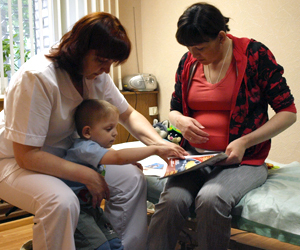
- We set aside the foot .The leg should be as straight as possible, the foot bent. Pressing on the inside of the knee, gently pull the leg outward.
- Rotation of the hip. The leg is bent .With one hand, we hold the finger of the foot, and the other with the knee in the direction of the desired movement. We bend the knee to the maximum possible angle, we do it slowly and at the same pace.
- Bend and unbend the ankle .Exercise is done slowly and with pauses. We hold the patient's toe with one hand and the leg on the other. We help the patient to bend and unbend the foot.
Bobat therapy training - video seminar:
Parents opinion
Feedback from satisfied moms, whose children were helped by Bobat-therapy.
The child crawled plastunski with 7.5 months, was already walking the ninth month, did not crawl on all fours, did not sit. We went to the Bobat, not even all the sessions went by, as they got sick, but the child crawled on all fours!and sat down in 9 months.
Irina
We have a special child, during the first course at 1.10 began to walk independently. Before that I went with support, there were prerequisites for independent walking. The course of Bobat-therapy pushed to make this process faster. After this, more than once the Bobat courses were repeated and there were always results in motor development.
Olga
If you want your child to achieve a positive result in the treatment with the method of Bobat therapy - be patient, because the elements of therapy should be used regularly and with great attention to the patient.

